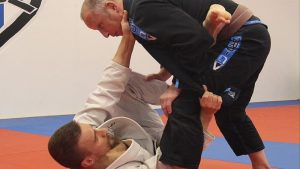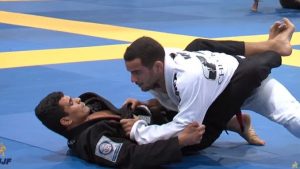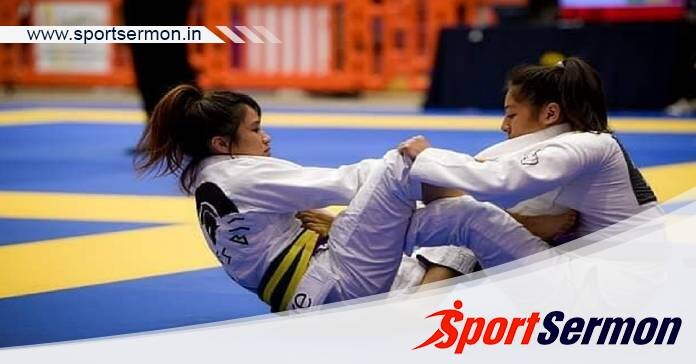Double Guard Pull: The sophisticated guard method used in Brazilian Jiu-Jitsu is well recognised. Many BJJ athletes pull guard during practice and competition in order to fall to the ground immediately. We can’t dispute that pulling guard is a great strategy to get your opponent to play to your strengths, even though it might be a contentious issue for most people.
The guard player may attack with their finest sweeps and submissions when they pull guard since they can move straight to the position they want. Because of this, we can encounter a double guard pull both in competition and in the practice arena. Let’s talk about how the double guard pull functions in BJJ in this post.
The Double Guard pull-in BJJ

The sport’s current meta includes pulling guard, notably in the Gi. The double guard pull occurs when both grapplers sit on the mat with the intention of playing the open guard (sitting open guard), which is mostly seen in the lighter-weight divisions. Although we occasionally see it in mixed martial arts, it is mostly a BJJ-specific strategy.
For grapplers who have a strong grasp of their guards, guard pulling can be a successful strategy. In comparison to other significant grappling martial arts, Jiu-Jitsu’s guard work is distinctive due to the vast array of guard techniques available. It is reasonable to argue that one of BJJ’s greatest contributions to grappling as a whole is the contemporary guard.
One leg control from the double guard pull posture is possible with grip placements beneath the opponent’s pants and ankle. Use ankle locks to strike and enter 50/50 if your opponent’s leg is on the same side as your own. To move the other person’s leg to either side of your body, move it. Once the opponent’s leg has been taken from the same side, a hook behind the knee is usually utilised to take possession. It allows you to push them when they are lying down or extend your leg such that it rests on top of their hip and securely grasps their ankle.
You might also be interested in reading this: The Paper Cutter Choke In BJJ: Everything You Need To Know
The Double Guard Pull Application by Mikey Musumeci

You can apply the ankle lock (outside ankle lock) and use your other leg for control or enter the 50/50 if the opponent’s leg is across rather than under control on the same side. Start eluding their defences as a fantastic alternative. You may get into the leg drag position by standing up and controlling your leg across.
In addition to taking a crab ride from the cross leg in the double guard pull position, the back mount is the most powerful position in grappling. By releasing the grasp on the pants to their hip, you can enter the crab ride from the pants and ankle grip. To disorient the adversary, invert to your side, start pursuing the crab ride, and work your way to the back mount or side control.
A frequent illustration of how both grapplers have confidence in their guard strategy is the double guard pull. In this situation, whoever has custody of the leg first will be in a better position. When both competitors have their legs on the same side, it becomes a never-ending leg-pumping battle, which causes them to retaliate by slamming their other legs inside. As soon as you get possession of your opponent’s leg, you should launch an assault to avoid waiting.
If their leg is crossed over your body, you should go closer to them, begin to scoot towards them, and then attack with a leg drag, berimbolo, or crab ride to get under their hips. As the opponent will attempt to free your legs by moving your feet down the mat to clear their hips and escape, keep your hook behind the opponent’s knee and your leg across their torso for control. When you have this control, your opponent cannot clear your legs. It enables you to keep up with their motions and will allow you to rapidly execute a guillotine grip to secure an ankle lock or grasp your collar to exert crushing pressure.
Keep in mind that your opponent’s defence is to re-pummel their leg to get inside position while you control their leg on the same side and across your body. The opponent can use the identical set-up to attack if their leg is inside. In this situation, the person who first obtains control of the leg will win.
The Double Guard Pull To Mount

Since it is a great alternative for individuals with dynamic guards, the double guard pull is common in the smaller weight divisions, as was already indicated. Starting from the double guard pull posture with both of your legs inside, post with your right leg on the left hamstring of the adversary and control their ankle with your right hand. Apply a de la Riva hook with your left leg to the right leg while holding the ankle with your left hand. Transfer your left-hand hold from the opponent’s ankle to their belt, focusing on the right hip in particular. Underright opponent leg, invert.
As you invert, keep moving your right foot to the left hip of your adversary. Pass your right leg beneath your opponent’s right knee as you twist to assume the leg drag posture. The other player will now begin defending by kicking her leg down. Grab the opponent’s left leg below with your left hand. As you roll back up, lock your guard into a triangular shape, and continue to slide backwards until you are on top, you will succeed. As you ascend till your right hand can seize the opponent’s collar, hold onto their left leg. Once everything is in place, you may start adjusting to the mount position while releasing your left-hand hold.
If you compete frequently, mastering the double guard pull is a crucial ability to have because it is a highly sophisticated posture. The best athletes of today use this strategy frequently and successfully. We advise you to give it a shot and check whether it functions properly for your game.
This is a complete guide on Double Guard Pull in BJJ. Let us know your thoughts in the comment section below.

